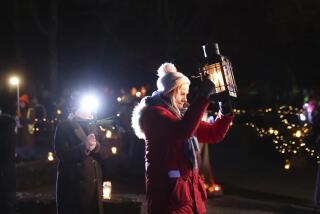Footloose in Ireland : Ancient Kinsale Warms One’s Holiday Heart
KINSALE, Ireland — About all this fishing village by the Atlantic Ocean in County Cork needs to make it the most colorful in the Emerald Isle is a few legendary leprechauns hanging around the boats down at the harbor.
Even without the mischievous elves, Kinsale’s old Georgian houses, maze of narrow streets climbing the hill leading up from the harbor and baskets of flowers hanging from posts throughout the village are enough to thump anyone’s heartstrings.
Kinsale dates from at least Anglo-Norman times, with the first Baron of Kinsale noted in 1223. In 1602 the Battle of Kinsale was lost by the Irish, causing the town to be colonized by the English as a naval station, the end of an Irish rebellion.
But what makes Kinsale attractive to visitors is its festive air, a holiday town famed with yachtsmen around the world. It has also in recent years become known for having an unusually large selection of gourmet restaurants and hotel dining rooms, probably the most celebrated group in Ireland.
And just to make sure that you drop a few quid in the shops, there is pottery, knitwear and other handicrafts to take home from the Auld Sod.
Here to there: Fly Delta, Northwest or Pan Am to Shannon, then drive or take the train 80 miles to Cork. Cork to Kinsale is an 18-mile drive. Dublin also is a port of entry, with Aer Lingus flying to Cork.
How long/how much? A full day and evening should do it for the town proper, yet this is the perfect place to relax longer, perhaps using it as a base for exploring the southern coast. Lodging costs are moderate, dining the same.
Few fast facts: The Irish pound recently traded at about 61 Irish cents to the dollar. Best time for a visit is late spring to mid-September.
Getting settled in: The Blue Haven Hotel ($70 B&B; double, low season, $79 high) is considered one of Ireland’s finest small hotels. Its food is held in similarly high regard. Can’t imagine a cozier place, with deep brocade chairs in the lounge, deep leather ones in the bar and a wood fire going in the flagstone fireplace. Rooms are a charming study of colorful bed coverlets, couches and curtains. Bowls of Irish potpourri give a lovely scent to the air.
The Blue Haven has its own 36-foot, oceangoing fishing boat, complete with tackle and gear, for guests.
Actons ($76 B&B; double, low season, $106 high) has a marvelous site right on the harbor and a small park. This member of the Trusthouse Forte chain is a larger and more commercial hotel, but it’s always lively with locals and folks down from Cork. Most bedrooms are very functional, some with fine views of the water. Rooms have self-catering coffee and tea gear and the breakfasts are an endless Irish feast of everything from warm soda bread to three kinds of meats and mushrooms with your eggs. Also a pool and sauna.
Hill Top B&B; ($39 B&B; double, $32 without private bath) looks down on the town and harbor from Sleaveen Heights just outside town. Rooms are small, neat and clean. Only two have private baths, but the immaculate shared baths are close at hand. Owner Maura McCarthy is justifiably proud of her own full-Irish breakfasts and happy to have you join her for the evening telly in the family room.
Regional food and drink: Seafood is great all over Ireland and, depending on the season, oysters from Galway Bay and Kenmare Bay are usually available. Mussels and salmon are just as plentiful. Also trout, sole and other deep-water fish can be found. Even Britons say the islands’ best shrimp comes from Ireland.
Moderate-cost dining: No visitor to Kinsale should miss a meal at the Blue Haven’s seafood restaurant, a delightful room with pink banquettes overlooking a colorful flower garden. You might start with half a dozen Kenmare Bay oysters, then move on to the Molly Malone seafood casserole of mussels and crab claws baked with garlic butter. Or fresh salmon en papillote (baked in an oiled paper bag) , plus turbot, plaice, monkfish, lotte or black sole.
Cottage Loft is at the town center in a historic building. Within are hanging pots and baskets of flowers, pink candles and covers on the tables. Excellent seafood again, including lemon sole stuffed with prawns and curried seafood kebabs. Carnivores will find lamb kidneys in a brandy and cream sauce, and roast duckling.
Bernard’s is also at the village center, presided over by a chef-owner who learned his skills on the Continent and displays them daily in this French-style restaurant.
There are an even dozen outstanding restaurants in this small port, so count your blessings rather than the calories.
On your own: Cork is Ireland’s largest county, its history a miniature version of the nation’s. People probably came here about 6000 BC, the presence in later prehistoric years confirmed by such oddities as “kitchen middens,” the mounds of oyster shells along the coast that date from a time when humans lived by fishing, hunting and gathering shellfish.
More fish are caught out of Kinsale’s harbor than from any other place in Ireland, a true mecca for the rod-and-reel set.
Kinsale has two notable 17th-Century forts that once guarded its harbor entry; both are worth visiting. And 12th-Century St. Multose is one of the last medieval churches still in use in Ireland.
For more information: Call the Irish Tourist Board, (212) 418-0800, or write 757 3rd Ave., 19th Floor, New York 10017, for brochures on Kinsale and Cork County. Ask for the Kinsale package.
More to Read
Sign up for The Wild
We’ll help you find the best places to hike, bike and run, as well as the perfect silent spots for meditation and yoga.
You may occasionally receive promotional content from the Los Angeles Times.






